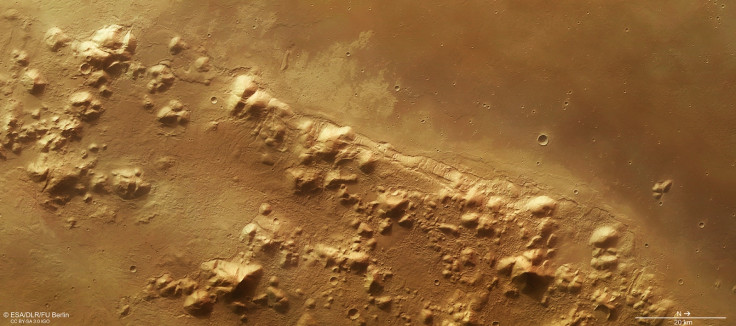Mars' mountain range could be sitting on massive ice deposits says ESA

Observations made by ESA's Mars Express spacecraft orbiting the Red Planet seem to indicate massive deposits of water ice hidden under a mountain range in the northern hemisphere.
Much of this ice is believed to be hidden 20m below the surface even today, says ESA.
This could hold big implications in the search for water, and hence, life on the planet.
Phlegra Montes range of isolated hills, ridges and small basins spanning 1,400 km on Mars provide evidence of glacial activity in the past in processes similar to those seen on Earth.
The range stretches from the Elysium volcanic region at about 30 degree N and deep into the northern lowlands at about 50 degree N, and is a product of ancient tectonic forces.
The tilt of the planet's polar axis is believed to have varied considerably over time, with the wobble affecting climatic conditions. This allowed the development of glaciers at what are today the mid-latitudes of Mars.
The features suggest material gradually slumped downhill through the presence of subsurface ice.
Additional evidence includes small valleys cutting through the hills and appearing to flow into regions of lower elevation, in particular towards the centre of the image.
The hummocky terrain provides a distinct contrast to the smooth plains that dominate the upper portion of this image.
The material here is thought to be volcanic in origin. "Wrinkle ridges" can be seen in the lava plain. These are attributed to the cooling and contraction of lava owing to compressive tectonic forces following its eruption onto the surface.
Phlegra Montes
The oblique view of the southernmost tip of the Phlegra Montes, generated from data acquired by the High Resolution Stereo Camera aboard ESA's Mars Express, shows the above features indicative of past glacial activity.
The camera resolution is about 15m (50ft) per pixel.
A study had linked the gully-like features found on the walls of impact craters in the planet's mid-latitude to glaciers that advanced and retreated many times in the "recent" past spanning million years.
That study also indicated that climate change is an ongoing process on the planet, aided by its wobbly rotation axis.
Meanwhile, Curiosity's findings in the Gale Crater also suggest that the ancient climate on the planet could have sustained many lakes.
The rover's images had shown structures on Martian rocks in the dry Gillespie lakebed similar in shape to those made on Earth by microbes, suggesting the presence of microbial life.
Other studies, more prominently an ETH Zurich study, have categorically ruled out oceans on the Red Planet at any time, claiming that in its 4.5 billion year history, the planet was characterised by intense heat and volcanic activity, which would have evaporated any possible water and made the emergence of life highly unlikely.
© Copyright IBTimes 2025. All rights reserved.





















